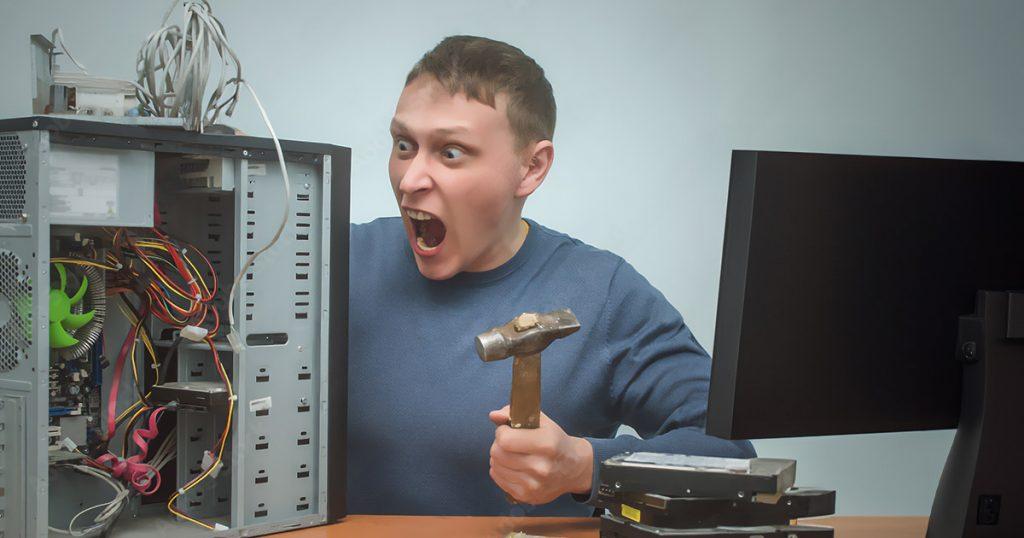Motherboards are like the heart of your computer. They make sure all the parts work together. But sometimes, they can have problems. However, like any complex system, they can experience motherboard issues that disrupt their functionality. It’s important to address these issues promptly to ensure your computer operates smoothly.
1. Motherboard Not Getting Power
Issue: If your motherboard isn’t getting power, it might be due to a faulty power supply unit (PSU) or loose connections.
Solution: Check if the PSU is connected to the motherboard and the power switch is on. If everything looks good, inspect the power cord and wall outlet for issues.
2. Motherboard Won’t Turn On
Issue: When your motherboard refuses to turn on, it could be one of the motherboard issues where there is inadequate power supply or faulty connections.
Solution: Ensure the PSU is providing sufficient power and look for loose connections between the power button and the motherboard. Consider resetting the CMOS.
3. System Fails to Boot
Issue: Another motherboard issue that happens is the failure to boot can be caused by loose or faulty components like RAM or the graphics card.
Solution: To troubleshoot the motherboard, check for loose connections and try booting with only essential components. If that doesn’t work, test the RAM and graphics card individually.
4. Random Freezing or Crashing
Issue: Random freezes or crashes may indicate outdated BIOS or overheating motherboard issues.
Solution: To fix the motherboard, update the BIOS to the latest version and ensure proper ventilation to prevent overheating. Consider running a memory diagnostic test to check for faulty RAM.
5. Blue Screen of Death (BSOD)
Issue: A BSOD usually occurs due to driver issues or hardware compatibility problems.
Solution: Update drivers, especially for the chipset and graphics card. Check for hardware compatibility and run a system file checker (SFC) scan to repair any corrupted files.
6. USB Ports Not Working
Issue: Inoperative USB ports may result from physical damage or outdated drivers.
Solution: Check for physical damage to the ports and cables. Update USB and chipset drivers. You can also troubleshoot the motherboard and ensure no conflicting software is causing the issue.
7. No Display on Monitor
Issue: When there’s no display on the monitor, it could be due to a misaligned graphics card or a faulty monitor or cable. It can also be a sign of a motherboard issue
Solution: Re-seat the graphics card, check the monitor and cable for issues, and try using a different monitor or cable.
8. BIOS Errors
Issue: Errors in the BIOS can lead to boot problems and instability.
Solution: To do motherboard troubleshooting, reset the BIOS settings to default, update the BIOS to the latest version, and check for hardware conflicts in the BIOS settings.
9. Overheating
Issue: Overheating can cause system instability and damage to components.
Solution: Ensure proper airflow inside the case, clean the CPU and GPU heatsinks, and consider adding additional case fans for better ventilation.
10. Ethernet or Internet Connectivity Issues
Issue: Connectivity problems can arise due to outdated network drivers or physical damage to the Ethernet port.
Solution: Update network drivers, check for physical damage to the Ethernet port, and reset the modem and router.
11. Noisy or Malfunctioning Fans
Issue: Noisy or malfunctioning fans can indicate dust buildup or failing hardware.
Solution: Clean the fans and heatsinks, replace any malfunctioning fans, and consider upgrading to quieter fans if noise is a concern.
12. Boot Loop
Issue: A boot loop can occur due to a variety of reasons, including faulty hardware or software.
Solution: Check for loose cables or components, reset the CMOS, and test the PSU with a tester to ensure it’s working correctly.
13. Motherboard Beep Codes
Issue: Beep codes indicate specific hardware or motherboard issues that need to be addressed.
Solution: To troubleshoot the motherboard, refer to the motherboard manual for beep code meanings, identify the issue based on the beeps, and take appropriate action to fix it.
14. PCI Slot Issues
Issue: Problems with PCI slots can result from improper installation or physical damage.
Solution: Ensure that PCI cards are properly seated, check for damage to the slots, and update motherboard drivers.
15. Faulty Capacitors
Issue: Swollen or leaking capacitors can cause various issues with the motherboard.
Solution: Inspect the motherboard for faulty capacitors and replace them with new ones to resolve the problem.
Understanding common motherboard issues and how to troubleshoot them is essential for maintaining a healthy computer system. By following the solutions outlined in this guide, you can address issues such as power problems, boot failures, and connectivity issues, ensuring that your computer runs smoothly. Remember, if you’re unsure about how to fix a problem or if it requires more technical expertise, it’s always best to seek help from a professional.
